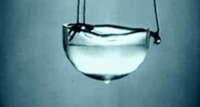
Photo from wikipedia
When a two-level system (TLS) is coupled to an electromagnetic resonator, its transition frequency changes in response to the quantum vacuum fluctuations of the electromagnetic field, a phenomenon known as… Click to show full abstract
When a two-level system (TLS) is coupled to an electromagnetic resonator, its transition frequency changes in response to the quantum vacuum fluctuations of the electromagnetic field, a phenomenon known as the Lamb shift. Remarkably, by replacing the TLS by a harmonic oscillator, normal-mode splitting leads to a quantitatively similar shift, without taking quantum fluctuations into account. In a weakly anharmonic system, lying in between the harmonic oscillator and a TLS, the origins of such shifts can be unclear. An example of this is the dispersive shift of a transmon qubit in circuit quantum electrodynamics (QED). Although often referred to as a Lamb shift, the dispersive shift observed in spectroscopy in circuit QED could contain a significant contribution from normal-mode splitting that is not driven by quantum fluctuations, raising the question: how much of this shift is quantum in origin? Here we treat normal-mode splitting separately from shifts induced by quantum vacuum fluctuations in the Hamiltonian of a weakly anharmonic system, providing a framework for understanding the extent to which observed frequency shifts can be attributed to quantum fluctuations.
Journal Title: Physical Review A
Year Published: 2018
Link to full text (if available)
Share on Social Media: Sign Up to like & get
recommendations!